
Common name:Carnarvon Gorge Macrozamia
Botanical name:Macrozamia moorei
An upright slow growing cycad with a rounded head of blue-green foliage. It is the largest of the Macrozamia and has been known to reach over 30 feet in the wild in Australia with a 2 foot thick trunk but is usually 10 to 13 feet, even with great age, and can be expected to be well under this size for many years in the garden. Still, it is a plant for a large garden as it has a spread from leaf tips that can be more than 15 feet wide. The growth point holds many 5 to 7 foot-long blue-green leaves that rise erect and then strongly arch over with 120 to 220 leaflets that face forward and are keeled along the rachis with soft pointed tips - the leaflets are 8 to 12 inches long in the middle of the leaf but reduced towards both the tip and the base with the basal leaves reduced to nearly spinelike all the way to the base of the leaf (important in distinguishing the species). Once mature, this plant puts on leaves continuously instead of in flushes like most other cycads do, and the full head of leaves can look somewhat palm-like or like grass trees (Xanthorrhoea or Dasylirion). As with other cycad genera, Macrozamia are dioecious, cone-bearing plants so there are plants that have male or female cones with the female cones typically broader and male cones usually longer and thinner. Plant in full sun to light shade in a well-drained soil and irrigate occasionally to infrequently. Hardy and evergreen to 20 °F. This cycad grows in Queensland, Australia from Emerald and Springure in the north to Injune in the south and west to the Carnarvon Gorge area where it is found in relatively high abundance. It is similar to Macrozamia johnsonii, which grows further to the south in New South Wales and has greener non-keeled leaves, and there is a slightly more blue-green color to the leaves that do not have the reduced leaflets all the way to the base of the leaf.
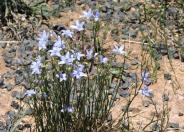
Common name:Tufted bluebell
Botanical name:Wahlenbergia communis
Tufted or open perennial herb growing to a height of 15" and spreading 12". Blue bell shaped flower on long stems in summer. Prefers moist, well-drained soils in full sun to full shade. In dry seasons, plants will die off and reshoot from the taproot in winter when conditions are more favorable. Frost and shade tolerant, it will die back in dry conditions and reshoot when moisture returns. Flowers from late spring, summer and early autumn. Flowers are pale to bright blue, bell shaped flowers held above the foliage on long stems. Foliage is blue-green forming tufts at the base of the plant. Attractive when used in mass plantings, in rockeries or cottage gardens. Also effective for combination plantings in pots.
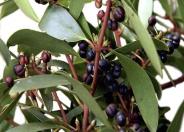
Common name:Mountain Pepper, Pepper Tree, Tasma
Botanical name:Tasmannia lanceolata
Broadleaf, evergreen shrub or tree, to 6-30 ft tall in natural environment. In the landscape, a shrub 8-12 ft tall and 4-8 ft wide. Compact rounded growth habit. Stems are bright red to purple-red in color. Leaf arrangement variable, alternate, then more sub-opposite or opposite towards the ends of branches. The leaves are aromatic, simple, tiny, lanceoate to narrow-elliptic, dark green with a pale underside. Male and female flowers are on separate plants, both in small terminal custers. Male flowers are pale brown to flesh colored and have 20-25 stamens. The small female flowers have 3-8 petals that are yellow-cream or white; they appear in late winter, spring or early summer (depending on the climate) and are followed by red and finally black, globose, tiny berries. Sun to part shade, prefers moist, well-drained soil; can tolerates strong winds but not maritime exposure. Understorey plants of open forests or temperate rainforests. A “bushfood” native pepper sold in Australia, it is produced from the dried leaves and berries of this plant.

Common name:Hairpin Banksia
Botanical name:Banksia spinulosa
Banksia spinulosa is a hardy species growing to approximately 6.5' tall and 3-5' wide. It is frost tolerant, grows well in coastal conditions and has very attractive flowers. The natural habit is a somewhat sprawling shrub, it is the named varieties that are best suited to garden use as they are generally more compact with better flowers. Characterized by long, narrow, green foliage which is attractive through the year, it is the flowers that appear from autumn through winter that are the main attraction to gardeners and birds alike.Large cylindrical flower spikes usually in tones of orange to red. In some cultivars these can reach 15cm in length, often smaller. Best grown in a sunny position in a well drained, humus rich, sandy soil, the new cultivars require very little care however tip pruning to maintain a bushy habit is recommended. Only use a specially formulated low phosphorus native plant fertilizer. Usually very little fertilizer is required. Yellow foliage is an indication that some may be needed. Mulch around the plant to maintain a cool root run and water deeply every few weeks through the first summer. The lower growing varieties make excellent potted specimens in a sunny position. The pot will lift the plant making the flowers more prominent as they appear. This shrub is frost tolerant and established plants are drought tolerant.
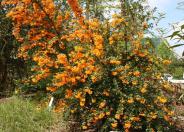
Common name:Darwin's Barberry
Botanical name:Berberis darwinii
Darwin's Barberry is an evergreen shrub that grows to about 6-8' in height and width. It comes from Chile and has the most unusual orange/red flowers that appear in March. The leaves are glossy and dark green. It is fairly low water once established. The thorns are not as pronounced as with other Barberries.
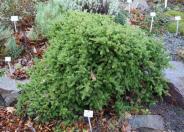
Common name:Alpine Totara
Botanical name:Podocarpus nivalis
Alpine totara is versatile evergreen shrub. It is native to New Zealand. It has dark green needles with a bluish sheen. It does well in both full sun and shade situations. It is great for cascading over a wall.It is an excellent filler plant. Once established, it tolerates considerable drought and can go through a typical summer without additional water. Occasionally it produces a few bright red fruit. It turns yellow in hot summers.
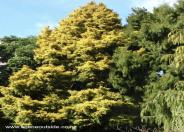
Common name:Totara
Botanical name:Podocarpus totara 'Aurea'
Golden-leafed cultivar of Podocarpus totara, a New Zealand native conifer. Pyramidal to columnar growth habit. The needle-like leaves are linear, sessile and tiny. Leaf color varies somewhat during the year from light green in spring, changing to yellow in summer, and deepening to golden yellow in winter. Plant in full sun for best foliage color. Prefers well-draining soil. Tolerates dry conditions once established. Responds well to trimming and is suitable for hedging purposes. Tends to have a bushy habit with foliage from ground level, but can be trained to grow as a specimen tree from an early age by selecting one shoot to become the central leader and gradually removing the side shoots. Make sure to stake the tree when planting in an exposed position. Suitable for coastal gardens. Tolerates moderate frosts, wind and is hardy throughout New Zealand. Does best in full sun and regular watering until established. Reaches 20 tall and 13' wide.
Smaller and slower growing than the species itself, Podocarpus totara 'Aurea' can be accomodated in garden settings for many years. Forms a nice dense hedge.
Designer: UC Berkeley
Photographer: Vicki Anderson
Maintain a two to four inch layer of mulch on the soil surface to reduce weeds, infiltrate rain water, and reduce compaction.
Develop healthy soil for plants that are vigorous and naturally pest-resistant.